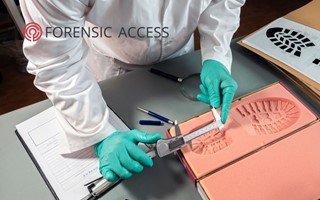News December 01, 2021
Forensic Access recently featured in the BBC’s new true crime series which explored the role of scientists in forensic investigations, showing how some of the UK’s most serious crimes were solved. Episode 14: Paint Materials and Blood Patterns covered Forensic Access’ resident BPA expert, Dr. Philip Avenell’s, involvement with the Gareth MacDonald case. Here we tell the story of how Blood Pattern Analysis was used to solve the murder and bring Mr. MacDonald’s killer to justice.
The body of Gareth MacDonald, 30, was discovered in a Travelodge hotel room after he sustained multiple blows to the head in September 2007.
He was found in a ground floor room at Heston services next to the M4 motorway early on the morning of Saturday 15th September. There was a significant amount of blood on the bedsheets and it appeared at an early stage that a fire extinguisher discovered at the scene was the murder weapon.
MacDonald, a father of three from Prestatyn, North Wales was headed to London with his boyfriend Glenn Rycroft, who he met online the year before. Rycroft claimed that MacDonald was safe and well when he left the hotel room at 07:00 that morning, but when he returned fifteen minutes later, he discovered MacDonald lifeless in a pool of blood.
However, there were no signs of forced entry, and Rycroft was stained with the victim’s blood with his fingerprints were discovered on the murder weapon. His explanation for this was that he attempted to hug Gareth’s body, which meant that he himself became covered in the deceased’s blood.
Rycroft’s actions had contaminated the crime scene, meaning that finding forensic evidence was now a major challenge. This is when the police turned to forensic science for help, enlisting the expertise of Dr. Philip Avenell who is a specialist in blood pattern analysis.
The police first submitted the shoes that Rycroft has been wearing at the time of his arrest. The right shoe had some blood staining on it but there was nothing particularly distinctive there, whereas the left shoe had a very clear impact spatter on it.
“The front on view the shoe showed a distribution of blood spatters across it of varying sizes – but many of them very small.
“Small blood stains won’t travel very far, so you can start to get an idea of how far away the perpetrator was. The shoe was close to impact with wet blood,” Dr. Avenell said.
Due to the colour and texture of the material that some items are made out of, it is not always easy to clearly see blood on an exhibit, particularly the fine detail. Because of this, scientists will make sketches or use software to represent basic images of an item, which can then be annotated to clearly show exactly where the blood appeared and the type of blood staining present.
“From the digital sketch you can see there is a lot more blood on there than is visible to the naked eye when you are looking at the exhibit. It really highlights that there was a heavy impact from wet blood that’s made its way onto the shoe,” Dr. Avenell said.
Rycroft claimed to have found MacDonald deceased when he went back to the hotel room, however the blood pattern evidence on Rycroft’s shoes told a different story. It showed that Rycroft could have been in the room when MacDonald was fatally injured. The police now had crucial evidence that potentially placed Rycroft at the scene of the crime.
The prosecution now required further proof of what had happened in the hotel room. Blood spatter on Rycroft’s shoes showed that he was in close proximity to MacDonald when there had been a heavy impact into wet blood, and further examination of Rycroft’s clothing was needed.
Dr. Avenell examined the trousers that Rycroft had been wearing at the time of MacDonald’s murder and had been recovered from Rycroft when he was taken into police custody.
“There was a lot of heavy blood staining on the trousers. This is what we call contact blood staining, where the item has leant into something that’s wet with blood or vice versa.
“There’s difficulties when you have lots of heavy blood stains and lots of different types of blood patterns overlaying each other. It then becomes quite difficult to work out exactly what’s there. That’s when you’re looking at the very fine, small detail in the blood,” he said.
Dr Avenell began an intricate examination of the blood stains on Rycroft’s trousers, finding a small yet vital clue. Around halfway up the left leg, the team found three very small blood stains which were identified as blood that’s travelled through the air and landed on the surface of the trousers.
The consistency of the blood was clearly different to that of the other blood stains, proving to be clotted blood which meant that these blood stains were made at a different time.
Dr. Avenell then turned his attention to the bedsheets. They were also soaked in blood, but amongst the heavy staining he discovered further evidence of clotted blood – just like on Rycroft’s trousers.
“We could see where the impact had happened and the blood radiated out from the point of impact. From the initial impact, the blood started to flow and then there was a time delay for that blood to start clotting. This showed there had been a second impact into the blood after that,” he said.
For Dr. Avenell, this information provided a sequence of events surrounding MacDonald’s murder. It showed that MacDonald had been struck once, then a minimum minutes later as the blood was beginning to clot, he was struck a second time.
“We knew there had been an impact into blood after there had been a period of time of bleeding. Typically, this is between three and fifteen minutes. It showed there had been at least two blows and that the blows were minutes apart.
“You look at what you’ve got and you try to understand the timeline of events and what has happened. It’s interesting when you then start to piece them together,” he said.
Blood pattern analysis by Dr. Avenell was pertinent to the prosecution’s case, providing police with the definitive answer which DNA evidence and fingerprints evidence would not have achieved.
In July 2009 Glenn Rycroft stood trial at the Old Bailey. He was found guilty of murder and sentenced to life in prison, serving a minimum of twenty-five years.
Blood Pattern Analysis Expertise
The world-class team of forensic scientists at Forensic Access operate in bespoke facilities. The forensic work we carry out is to the highest quality standards.
We have a dedicated team of Casework Managers who support all defence work, providing end-to-end assistance and coordination. The Casework team has direct access to our team of scientists, helping barristers and solicitors prepare a more effective defence strategy, and all expert witness reports are thoroughly documented and peer reviewed.
To learn more about the forensic services we offer, or to receive a free consultation and quote, please fill-in our contact form or Tel: 01235 774870.


